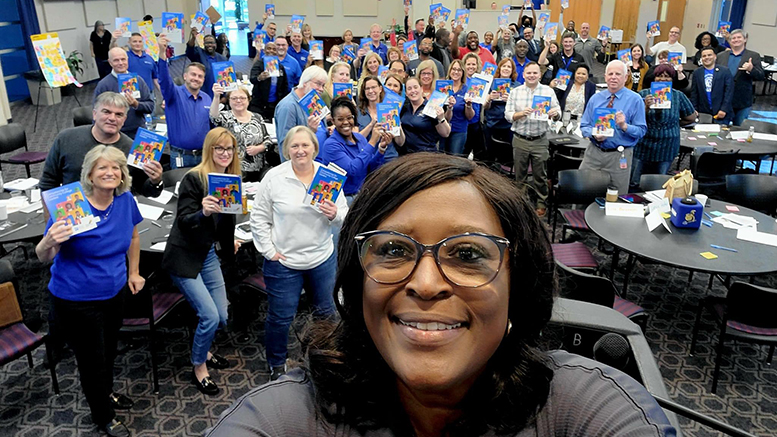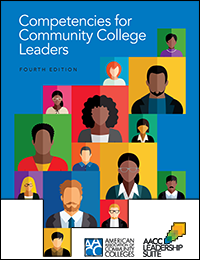Since taking over as president of Alvin Community College in Texas in 2021, Robert Exley has been introducing his executive team to the leadership traits and abilities known in the community college world as competencies.
Competencies are spelled out in a slim booklet published by the American Association of Community Colleges. An updated fourth edition was introduced last year. The guide, “Competencies for Community College Leaders,” is intended to be used by colleges as a resource to hone employee skills, improve evaluations and provide reassurance to leaders in turbulent times.
Exley is a long-time fan of the competencies.
“You can’t be a cognitive behavioral scientist by training and not love this stuff,” he said, referring to his educational degrees.
He was especially grateful for a tried-and-true guide when he assumed the presidency of a community college working its way out of the disruptions caused by the Covid pandemic.
A prompt for self-analysis
Exley’s first step was to ask his cabinet members to do a self-analysis based on the competencies relevant to their positions.
“As one would expect, that was easier for some than others,” he said.
For some months, he continued to initiate conversations about the competencies during meetings. Then came performance review time. Rather than using a more standard measurement for evaluations, Exley asked his vice presidents to identify which of the leadership competencies they relied on in the areas in which they considered their divisions to be the most successful.
“It freaked them out,” he said. “It was a long, narrative assignment, and some folks are more comfortable than others with writing narratives.”
Leadership for all
Exley believes that a focus on leadership competencies builds executive skills and encourages employees across divisions to work as a team instead of in silos. When a vice president’s job recently opened up at Alvin, he decided to write the pertinent leadership competencies directly into the job description.
“Everybody always wants to know your credentials,” he said. “And your experience. We want to know your demonstrated competency as a leader.”
Teamwork and expanded leadership skills are two of the outcomes AACC had in mind when it created the first competencies guide in 2005 and when it published the fourth edition last year.
“It’s very impactful within the sector, and people use it as that guiding document for leaders,” said Angel Royal, senior vice president of strategic initiatives at AACC and author of the latest edition.
“I tell people all the time, ‘You’re not going to walk in the door with every single skill that’s necessary to be successful,’” she said. “It’s important that you are aware of those areas where you need to work to improve.”
Culling experiences
The competencies guide is meant to be a flexible document that colleges can use in ways they find most helpful, Royal said. The new version lays out dozens of skills and attributes desirable at five levels: faculty, entry-level, manager, executive and chief executive officers. For the first time, it includes practical steps that employees can use to move to the next level of leadership — from faculty to department chair, for instance.
The latest edition is the result of a collaborative process involving stakeholders of varying ages, ethnicities and stages in their careers. In conversations spanning a couple of months, they talked about how leadership at all levels in community colleges has been affected by seismic events, most notably the Covid pandemic and the racial reckoning that followed the May 2020 murder of George Floyd by police officers in Minneapolis.
“These are very hard jobs,” Royal said. “People are under attack in these jobs. And they’re extremely complex. When you talk about leaders having the right skills, they also have to have the appropriate supports.”
On the same page
Kimberly Beatty, chancellor at Metropolitan Community College in Kansas City, said she ordered about 60 copies of the latest edition.
“It’s about how you collaborate and how you communicate and how you address some of the critical issues that are happening in today’s society,” she said. “Higher education is changing dramatically, and you’ve got to have some type of resource to be helpful to you as you make those changes.”
Beatty distributed copies to the people who report directly to her and to those leaders’ direct reports. Shared governance leaders, including the leaders of faculty and staff associations, also received copies.
Beatty encourages employees in her four-campus system to use the guides as a professional development tool.
“It demonstrates that you can lead from no matter what seat you’re in,” she said. “And the people striving for the next level can see that these are the expectations, and this is what those behaviors look like.”
The guides also help remove ambiguity from decision-making, Beatty said. She recounted a recent conversation with an employee in which she used the guide to resolve a question.
“It was right there,” she said. “And that’s how I know that I am on target.”
Various uses in the field

Since the most recent publication date, Royal has been meeting with college leaders and related groups to help them maximize the value of the guide. She encouraged the Iowa Association of Community College Trustees to use the competencies as a component in CEO evaluations and also as a resource to shield college leaders from escalating backlash in response to unpopular decisions.
“As trustees, if you have charged your leader with doing this work, you have to support them,” she said. “You can’t leave them hanging when this happens.”
The competency guides, which spell out a progression of skills for people aspiring to CEO and other top jobs, can also be used for succession planning, Royal said.
“You’re growing them up to the positions that you know you’re going to have vacant,” she said.
Initiating coversations
The competence guides are frequently used as part of college in-service training.
St. Petersburg College (SPC) in Florida centered a full-day training session in January on the AACC competencies. More than 70 faculty and staff attended, representing mid-level and senior leadership from all areas of the college.
“There were some robust discussions about how to use the competencies and what they mean on an individual basis,” said Tonjua Williams, St. Petersburg’s president. “But what was exciting to see were the conversations about how they intersected across areas and leadership levels.”
Williams, whose first job at SPC was accounting clerk, said she appreciates that the new version of the competencies guide includes a section for entry-level employees, with a clear roadmap for advancement. Eventually, the college plans to incorporate the competencies into professional development and evaluations for all levels of its workforce.
“We all start somewhere,” Williams said. “It’s so important to acknowledge that all employees have aspirations for growth and it’s our responsibility to help them get to the next level.”
Rebuilding relationships
Back at Alvin Community College, Exley required a competency-based self-assessment of himself as well as cabinet members. He looked at what had gone well over the past year and determined that the competencies crucial to the advocacy component of a CEO’s job had helped him rebuild Covid-damaged relationships with K-12 schools in his region and navigate a new state funding system.
“I’m a better listener now than I was a year ago because I really focused on that,” Exley said.


